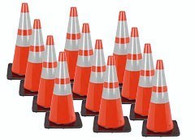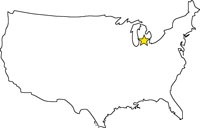The History of Traffic Cones
2nd Jan 2018
Believe it or not, traffic cones are considered one of America’s most important inventions. Traffic cones are used every day by road crews as a notification to drivers to not enter that lane or roadway. Traffic cones are nothing novel to the modern driver, but they probably don't know the tool's history and impact on road safety. The cones originated over 75 years ago, as the invention of a Los Angeles road worker and sign maker.
The Very First Traffic Cone
In 1940, Charles Scanlon, a Los Angeles street painter, designed a ballasted, hollow cone-shaped marker to keep cars from driving on fresh paint. At this time, most road markers were made of wood, which was not a convenient or long-lasting material. These wooden signs were run over often and demolished.
Scanlon knew there was an opportunity to make something better than these wooden signs. He created the first safety cone by sewing together used tire skins. He worked on the cone with the help of sign operator Rodney Taylor.
In 1943, Scanlon patented the safety marker. The patent description included how the marker sought to improve road safety by being made with a “resilient” material that wouldn't break or cause damage to cars if hit. The base was heavy so that it could withstand wind and not topple over. It had a top hole and feet. This allowed for easy stacking, and the feet lifted the cone from touching painted asphalt.
In 1947, the Interstate Rubber Products Corporation began manufacturing the cones. Its owner was an associate of Scanlon and Taylor. The cones were made by placing rubber sheets into a mold. Then they were heated under high pressure. Los Angeles began to use the cones, replacing iron handles.
Safety Cone Traffic Corporation's Safe-T-Cone
The cones soon piqued the interest of others. The Radiator Specialty Company, located in Charlotte, N.C., owner Isador Blumenthal saw the potential and talked to Interstate Rubber about an East Coast partnership, but they declined. So, Blumenthal started his own cone company. The company, Safety Cone Traffic Corporation, started producing square-based cones. The product was similar to that of the Interstate Rubber Products Corporation, yet the company was able to secure a new patent for the “Safe-T-Cone.” With this, safety cones were now being mass-produced on the East and West coasts.
By 1958, the safety cone was international, as the use spread to the UK. Also in 1958, Pacific Gas and Electric Company used cones to create work zone boundaries. This helped protect workers as they loaded and unloaded trucks.
Inclusion in The Manual on Uniform Traffic Control Devices
The cone first appeared in The Manual on Uniform Traffic Control Devices (MUTCD) in 1961. The rubber cone was described as being painted yellow or yellow-orange and having red trim at the top.
Influenced by a high rise in traffic accidents and fatalities, the federal government enacted the Highway Safety Act, elevating the MUTCD from recommendations to mandates. The safety cone was designated as a safety tool for public roads and work zones. The MUTCD further established requirements for the safety cone in 1971. It defined the requirements for the safety cone, including a minimum height of 18”, and that it should be reflective and/or lighted when used at night. It also stated that placement should include areas “where speeds are relatively high or wherever more conspicuous guidance is needed.” The MUTCD later mandated that cones be a minimum of 28” when used on freeways.
From one simple idea to universal usage, the cone went from something that solved one problem to a global safety tool. They are found on roadways, parking lots, city streets and many other spaces that need to inform cars to stop or avoid the area. Take a look at the different traffic cones available from Dornbos Sign.




